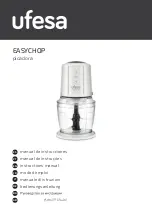HOST INTERFACE (HI)
5 - 10
PORT B
MOTOROLA
Port B uses the DSP CPU four-phase clock for its operation. Therefore, if wait states are
inserted in the DSP CPU timing, they also affect Port B timing. The result is that ports A
and B in the previous synchronization example will always stay synchronized, regardless
of how many wait states are used.
5.3
HOST INTERFACE (HI)
The HI is a byte-wide, full-duplex, double-buffered, parallel port which may be connected
directly to the data bus of a host processor. The host processor may be any of a number
of industry standard microcomputers or microprocessors, another DSP, or DMA hardware
because this interface looks like static memory. The HI is asynchronous and consists of
two banks of registers – one bank accessible to the host processor and a second bank
accessible to the DSP CPU (see Figure 5-8). A brief description of the HI features is pre-
sented in the following listing:
Speed
3.3 Million Word/Sec Interrupt Driven Data Transfer Rate (This is the maximum interrupt
rate for the DSP56002 running at 40 MHz – i.e., one interrupt every six instruction cycles.)
Signals (15 Pins)
H0–H7
Host Data Bus
HA0-HA2
Host Address Select
HR/W
Host Read/Write Control
HEN
Host Transfer Enable
HREQ
Host Request
HACK
Host Acknowledge
Interface – DSP CPU Side
Mapping: Three X: Memory Locations
Data Word: 24 Bits
Transfer Modes:
DSP to Host
Host to DSP
Host Command
Handshaking Protocols:
Software Polled
Interrupt Driven (Fast or Long Interrupts)
Direct Memory Access
Instructions:
Memory-mapped registers allow the standard MOVE instruction to be used
Special MOVEP instruction provides for I/O service capability using fast interrupts
Bit addressing instructions (BCHG, BCLR, BSET, BTST, JCLR, JSCLR, JSET,
JSSET) simplify I/O service routines
I/O short addressing provides faster execution with fewer instruction words
F
re
e
sc
a
le
S
e
m
ic
o
n
d
u
c
to
r,
I
Freescale Semiconductor, Inc.
For More Information On This Product,
Go to: www.freescale.com
n
c
.
..


















